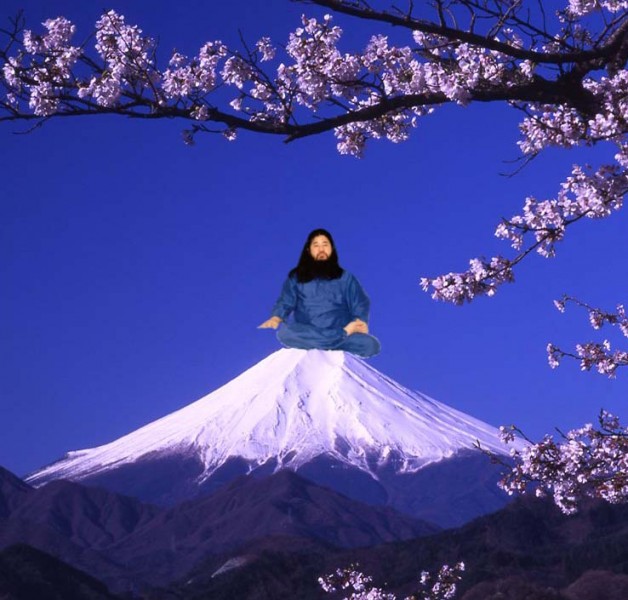A recent conversation with the Grand Nawashi who sits atop Mt Fuji, or at least one of them, prompted me to ponder the wisdom of adopting Japanese words to add to the jargon of shibari. I mean, we do speak English so maybe that’s the best langauge to use for easy comprehension? There are so many traps for the unwary non-native speaker. In this case, amongst other things, I was taken to task for failing to understand that the ‘ts’ of ‘tsuri’ apparently becomes ‘z’ to become ‘zuri’ if it is preceded by a descriptive part of the name, e.g. yokozuri. For example, if I understand correctly, that one could write “he performed a tsuri” but it would be “he performed a yokozuri”. I must say that, in my ignorance, I had assumed that these variations were merely different ways of expressing the same phonetic or regional differences in pronunciation. So, it seems we are wrong to write ‘yoko-tsuri’. The hyphenation is only a matter of convenience for ease of reading as far as I know. The only rule is one of consistency.
Of course, we all know of the hazards of relying on Google Translate or dictionaries to try to find approriate words or phrases. It is always wise to consult a native speaker as too often one ends up looking a fool, instead of cool. Of course, this also adds misinformation to the subject, e.g. ‘sakuranbo’, a tie unheard of in Japan. I know enough Spanish to know how careful one has to be when asking a shopkeeper if he has eggs, since ‘huevos'(eggs) is also the slang for ‘testicles’. No doubt, it is just as easy to commit similar improprieties and gaffs in Japanese, probably easier.
Whilst one might understand the direct translation of a word, it can often carry greater meaning. One example of this would appear to be ‘ryu’; a word that I had taken merely to mean ‘school’ or ‘style’. This is a gross oversimplification.
Concise Oxford English Dictionary gives us:
ryu /rɪˈuː/
▶noun (pl. same or ryus) a school or style in Japanese arts, especially in the martial arts.
– origin from Japanese.
Join as a free or paid member to read on…
[private] In simple terms, Dave Lowry of Shudokan Martial Arts Association says “The ryu is attempting to organize perception and physical responses in distinctive ways that are consistent with the founder’s principles” but it is more than that. You can read the full article here. I gained some insight into the weight of this word from Wayne Murumoto’s article ‘What is a ryu?’ :In many traditional Japanese arts that were started in what we can crudely correlate to being a medieval era, the founder of the style experienced what amounted to a divine revelation. These experts had already developed a vast repertoire of technical knowledge through a study of martial methods and through actual experience in battle and/or in training. But having exhausted and reached the limits of their technical expertise, they consciously underwent shugyo, or a rigorous training that tested their mind, body and spirit.
Often enacted in the confines of sacred ground such as a Shinto shrine or Buddhist temple, or in a hidden religious refuge in the wilderness or mountaintop, shugyo was meant to crack through the surface layer of the physical world to lay bare the secrets of the spiritual universe. Like the intensity of Zen training, after exhausting the everyday avenues of awareness, the trainee undergoing martial arts shugyo attains a new and enlightening insight.
After this period of intense training, prayer, and some kind of fasting and/or abstention, a vision would appear to the founder, that would give him the key to true mastery of his art. Often just a simple phrase or very rudimentary technique(s), the revelation would be the key that unlocked all the subsequent methods that the founder would develop. As such, the revelation was tenshin shoden, or knowledge bestowed from the Heavens, or muso; knowledge gained from a heavenly dream.
The knowledge, therefore, was heavenly pure when it was first passed from the gods to the first generation. If it is to remain a divinely inspired system, then it must always flow back to this person, the founder. Hence, the term -ryu, or nagare; it is a flow back to the wellsprings of the style, which was divine inspiration.
I was pulled up for adding ‘ryu’ to my own design takate-kote or should I now say box-tie? 🙂 Having read the above, I can see that I am disqualified on the grounds of lack of divine inspriration at the very least. In fact, I’m not sure how us aetheists can ever form a ryu since we can’t obtain divine inspriation as non-believers. Is a light on the road to Damscus essential first? I think this calls for another trip up Mt Fuji. Anyway, meanwhile I plan to try to follow the KISS (Keep It Simple, Studid) mantra of my previous incarnation as an IT salesman. Apart from words like kinbaku, takate-kote etc. that are common currency, I shall resolve to try to speak English. Anyway, I am off to document and photographs the steps of the Esinem style..erm, box-tie now…available soon in all good retailers 😉
[/private]
